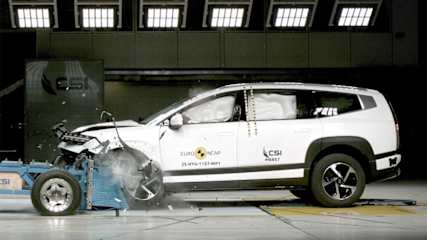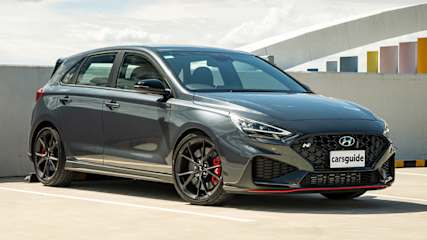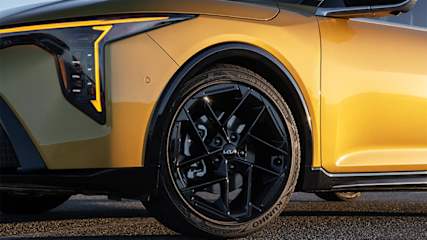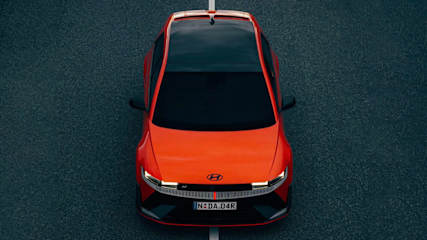Hyundai i10 Reviews
You'll find all our Hyundai i10 reviews right here.
Our reviews offer detailed analysis of the 's features, design, practicality, fuel consumption, engine and transmission, safety, ownership and what it's like to drive.
The most recent reviews sit up the top of the page, but if you're looking for an older model year or shopping for a used car, scroll down to find Hyundai i10 dating back as far as 2019.
Hyundai Reviews and News

Hyundai safety smashes the top-shelf barrier
Read the article
By James Cleary · 09 Sep 2025
Hyundai’s just-released Ioniq 9, a large, three-row electric SUV, has come through independent Australasian New Car Assessment Program (ANCAP) safety testing with a maximum five-star rating.Evaluated against the organisation’s latest 2025 protocols, the dual-motor, all-wheel drive six- and seven-seater 2026 Hyundai Ioniq 9 impressed across ANCAP’s four key pillars - Adult Occupant Protection (84 per cent), Child Occupant Protection (86 per cent), Vulnerable Road User Protection (77 per cent) and Safety Assist (85 per cent).In announcing the result ANCAP Chief Executive Officer Carla Hoorweg said, “Consumers and fleet buyers can be confident the Ioniq 9 provides high levels of protection for occupants, as well as other road users.”Adopting test results from sister organisation Euro NCAP, ANCAP called out numerous Ioniq 9 safety highlights including a stable passenger compartment in frontal offset testing and maximum points for protection of the driver in the full width and side impact tests.At the same time maximum points were awarded for child dummies in the frontal offset and side impact crash tests, with head-protecting airbags extending to the third row.The car’s active bonnet, designed to minimise injury in a pedestrian impact, also came in for special mention as did “high levels of performance across a range of collision avoidance test scenarios – particularly detection and crash mitigation with cyclists and motorcyclists”.Further detail on the Hyundai IONIQ 9's safety performance is available at www.ancap.com.au.

Popular hot hatch hit with price hike: 2026 Hyundai i20N and i30N prices jump to offset NVES impact
Read the article
By James Cleary · 03 Sep 2025
Hyundai Australia has raised the price of its highest-profile hot hatch and sedan models as a direct result of the federal government's New Vehicle Efficiency Standard (NVES) regime and “European factory sourcing”.

Urgent recall issued for popular small car
Read the article
By Laura Berry · 03 Sep 2025
Hyundai Australia has issued an urgent recall for almost 20,000 examples of its i30 hatchback following the discovery of a fuel fault that could lead to a sudden loss of power.The fault affects only the i30 PD model made between 2020-2021 and involves 18,634 vehicles in Australia.Hyundai Australia has issued a statement explaining the fault is connected to the fuel supply which can cause the vehicle to lose power.“Due to a manufacturing defect, the fuel pump impeller may become deformed under certain environmental conditions, interrupting the fuel supply,” Hyundai’s statement reads. “If this occurs, the engine could stall resulting in a sudden loss of motive power.“Owners of affected vehicles will be contacted in writing by Hyundai Motor Company Australia (HMCA), asking them to schedule an appointment as soon as possible to have the fuel pump impeller inspected and replaced, free of charge.”Owners who may be concerned are encouraged to speak to their local dealer or contact Hyundai’s customer care line on 1800 186 306.The i30 has long been in Hyundai’s top three best-selling vehicles. Sales of the i30 year-to-date to the start of September have totalled 7447 units. Hyundai’s latest recall follows another recall in March for the 8700 ix35 SUVs due to a brake fluid leak.
.jpg)
Hyundai’s historic moment: Korean brand moves to seven-year warranty in Australia, joining its Kia sister brand as pressure from Mitsubishi, Nissan, MG and GWM mounts
Read the article
By Tom White · 01 Sep 2025
Hyundai has officially moved to a seven year and unlimited kilometre warranty.The Korean brand was the first in Australia to move to a five year warranty in 1999, although is later to the party with the seven-year offering, which its Kia sister company was first to back in 2014.Hyundai’s new seven year promise isn’t unconditional. It adds to the existing five-year and unlimited kilometre warranty only as long as the car continues to be serviced inside the brand’s authorised dealer network on time.For those who recently bought a Hyundai, this new policy is backdated to the first of June 2025. If the warranty is extended it also extends the owner’s subscription to the over-the-air Bluelink service to the length of the warranty.Commercial vehicles and passenger vehicles, which are used for commercial applications are excluded, with commercial vehicles like the Staria Load retaining a five-year and 160,000km warranty.If passenger cars are serviced outside Hyundai’s dealer network, they retain the standard five year and unlimited kilometre warranty.High voltage components in electric cars continue unchanged, with eight years and 160,000 kilometres of coverage.The warranty wars are well and truly back on in Australia, as new Chinese players aim to overcome question marks about their longevity with long warranty promises. While some of Australia’s favourite automakers extend their warranties to keep up.Chery, GWM and JAC offer seven year warranties, joining Kia, Skoda and SsangYong. Mitsubishi, Nissan and MG offer conditional 10-year warranties, which also require servicing inside their respective dealer networks. Chery’s premium arm, Jaecoo, offers eight years and unlimited kilometres of warranty, just to name a few shaking up this space.The brand’s Chief Executive Officer in Australia, Don Romano said: “As the first automotive brand in Australia to offer a 5-year unlimited kilometre warranty, we recognise the strategic importance of competitive warranty coverage."“Over the past few months, we have worked closely with our National Dealer Council to develop a compelling and highly attractive warranty package that provides further peace of mind for our owners.”Hyundai will look to defend its top-five position in the Australian market in the coming years, as rivals, new and old, put the pressure on.For now, things are looking up for the Korean favourite, with its sales up 14.3 per cent year on year off the back of a strong performance by its core offerings, the Kona small SUV (up 26.2 per cent), Tucson mid-sizer (up 9.9 per cent), and radically restyled new-generation Santa Fe (up 22.5 per cent). Bolstering the brand later this year will be the arrival of the next-generation Palisade large SUV.
.jpg)
Toyota HiLux in trouble as Hyundai’s new dual-cab ute takes shape in fresh renders ahead of its arrival to battle the Ford Ranger and BYD Shark 6 later this decade
Read the article
By Dom Tripolone · 30 Aug 2025
Hyundai is building a ute to battle some of the biggest names in the business.

'We're in a different league': Why Hyundai says its premium push will be very different to Mazda's CX-60, CX-70 and CX-80 rollout
Read the article
By Andrew Chesterton · 30 Aug 2025
Hyundai says its premium push will look very different to rival Mazda's, declaring itself in a "different league" to the Japanese brand, and assuring its vehicles will still cover the full price spectrum.
.jpg)
Secret to China's success exposed by new report ranking the best and worst: Chinese car companies such as Nio and Xiaomi leaving Nissan, Mazda Toyota behind in tech
Read the article
By Laura Berry · 25 Aug 2025
New Chinese carmakers such as Xiaomi, Xpeng and Nio are leaving established manufacturers such as Toyota, Nissan and Mazda behind when it comes to technology a new report has found, leaving doubts about whether the traditional players can ever catch up.

Take that China! 2026 Kia K4 hatch to hit the small-car sweet spot against the MG5, Toyota Corolla, Mazda 3 and Hyundai i30 as Kia doubles down on affordability
Read the article
By Byron Mathioudakis · 22 Aug 2025
Kia has reiterated its focus on affordability in Australia, with the imminent K4 five-door hatchback to slot alongside the K4 sedan released earlier this year to help it fight off cut-price alternatives from China.Sourced from Mexico but designed for global markets including Europe, the Cerato hatch replacement may even start from under $30,000 (all prices are before on-road costs), matching the Hyundai i30 Sedan (from $29,000).But, even if the K4 Hatch goes slightly over that price, it would likely still undercut the best-selling Toyota Corolla Ascent Sport Hybrid (from $32,110), as well as the Mazda 3 Pure (from $31,310) and Hyundai i30 N-Line (from $36,000) hatchback equivalents.With the Picanto city car from $18,690 currently Australia’s cheapest new vehicle, as well as the Stonic S small crossover from $25,660, K4 Sedan from $30,590 and Seltos S from $30,750, the K4 Hatch should substantially boost Kia’s fortunes at the bottom end of the new-car market.Feeding into consumer preference for hatchbacks over sedans in the small car segment, the sharply-styled K4 five-door looks – and is – shorter, yet has a larger (and more practical) cargo area, at 530 litres versus the four-door’s 508L.Plus, as with many other models, the newcomer has undergone an Australian-road tuning program run by engineering specialist, Graeme Gambold, giving it a distinct advantage against many other small-car alternatives.According to Kia Australia product planning manager, Roland Rivero, Kia is committed to providing accessible small cars that Australian buyers want, especially as competitors abandon them for crossovers and SUVs.“Picanto not going anywhere anytime soon, and it remains our entry into the Kia brand. And we're pretty happy with what Picanto has done for us, and that's going to be around for a long, long time yet,” he told CarsGuide.“And as for K4 is not going anywhere either, and K4 is going to have a full life, and we've committed to the Mexican factory to do our respective share. So far so good.”While the sedan version has tripled the preceding Cerato hatch and sedan’s January to July sales this year compared to the same period last year with 3322 registrations, it will be the hatch that presents the most promising volume opportunity in Australia.“Obviously, we can't wait for the hatchback to come along,” Rivero admits. Because that's what the market appetite is for. What was the split that we had with Cerato hatch to sedan? I think it was, like, 65 per cent hatch, versus 35 per cent sedan… (Australia) is a hatch market.”Of course, it isn’t just benevolence driving Kia’s move to offer greater small-car choice, since it seeks to better-offset their smaller carbon footprint against the larger, thirstier and dirtier SUVs (as well as the Tasman ute), reducing the likelihood of coming New Vehicle Efficiency Standard (NVES) penalties.That’s why the K4 Hatch will switch to an Atkinson Cycle 2.0-litre four-cylinder petrol engine – as found in the current Seltos as well as the related i30 Sedan 2.0P – that is more efficient and emits, according to Rivero, some 30 per cent fewer emissions than the regular, 112kW/192Nm version found in the K4 Sedan. The trade-off is a slight loss of power and torque, at 110kW and 180Nm respectively.Given the Hatch is poised to be the K4 volume seller, that should help Kia’s bottom line in more ways than one.
.jpg)
Next-gen Mazda CX-5 rival takes shape: 2026 Hyundai Tucson design comes together but when will this popular Toyota RAV4 competitor come to Australia?
Read the article
By Tim Nicholson · 19 Aug 2025
One of Australia’s most popular SUVs is gearing up for a new-generation changeover in the next 12 months, and now we have an idea of what it might look like.

Move over China, this decade belongs to your closest rival: why the 2020s belong to Hyundai and Kia, not China, Japan or Germany | Opinion
Read the article
By Byron Mathioudakis · 19 Aug 2025
Sorry, Swifties.
While we appreciate the cultural phenomenon that is singer/songwriter, artist and philanthropist Taylor Swift, this is not a paean to a great pop star, but, rather, a reference to the year that marked Japan’s stellar ascension as the biggest threat to the established carmakers of that time. Their fear was existential as well as actual.




